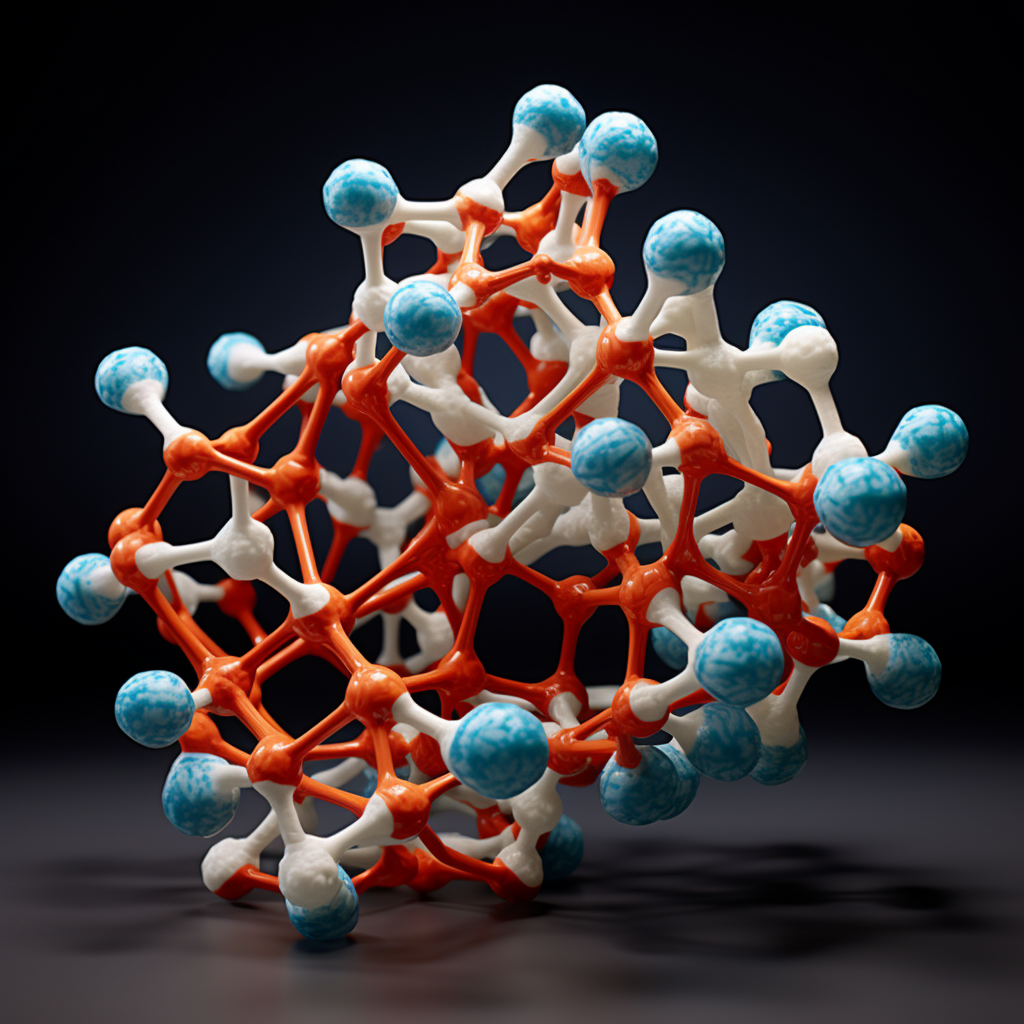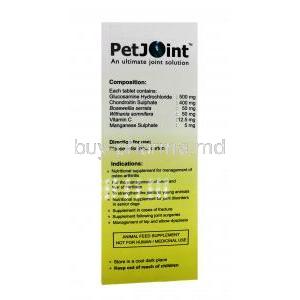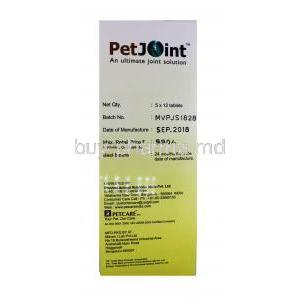Petjoint
- Introduction
- Composition of PetJoint
- Uses of PetJoint
- How PetJoint Works
- Dosage and Administration
- Common Side Effects
- Important Precautions
- Contraindications
- Careful Administration
- Off-Label Use of PetJoint
- Interaction with Other Medications
- Warnings
- Storage and Handling Precautions
- Administration to Special Populations
- Overdosage
Introduction
In the growing field of veterinary medicine, experts are constantly looking for new ways to improve the health and happiness of pets. PetJoint stands out as an example of this commitment, specifically focusing on promoting healthy joints for our furry friends. This guide aims to shed light on the features and advantages of PetJoint, highlighting its importance in the world of pet healthcare.
Composition of PetJoint
- Key Ingredients: The composition of PetJoint is a crafted blend of specific elements, each with an important role in strengthening the joints. Glucosamine and Chondroitin sulfate are prominently featured due to their known effectiveness in supporting cartilage health.
- Supporting Substances: In addition to the ingredients, a range of complementary substances has been included to improve the product's stability and how well it can be absorbed by the body, ultimately maximizing its effectiveness.

Uses of PetJoint
- Glucosamine:
- Stimulates cartilage and synovial fluid synthesis.
- Aids in managing inflammation.
- Prevents gradual cartilage injuries due to its antioxidant properties.
- Increases water holding capacity, flexibility, cushioning ability, and resilience of joints.
- Chondroitin Sulfate:
- Improves cartilage quality by stimulating proteoglycan synthesis.
- Inhibits proteolytic enzyme formation and release, reducing cartilage damage.
- Aids in managing inflammation.
- Manganese:
- Important for cartilaginous acidic mucopolysaccharides (AMPS) formation.
- Component of the antioxidant enzyme manganese superoxide dismutase (MnSOD).
- Boswellia serrata:
- Contains boswellic acid, beneficial for arthritis management without side effects.
- Withania somnifera (winter cherry):
- Supports joint health.
How PetJoint Works
PetJoints effectiveness is rooted in its way of working. It helps the body produce cartilage while preventing its breakdown, creating a favorable environment for joint health. This two-pronged approach not alleviates the symptoms of joint deterioration but also promotes the long-term preservation of joint function.
Dosage and Administration
At PetJoint, our administration process is carefully adapted to suit the requirements of each pet, considering factors such as their size and weight. We have designed the method of administering treatment, whether it's through means or otherwise, to be convenient and hassle-free for pets. The frequency and duration of treatment are adjusted to ensure therapeutic results, resulting in noticeable enhancements in their mobility and overall comfort.
Common Side Effects
Although PetJoint is known for its safety record, there may be instances where pets experience minor side effects. These effects are usually temporary. It can include mild gastrointestinal discomfort and slight lethargy. By monitoring and adjusting the dosage, these effects can be minimized to ensure that pets still receive the benefits of PetJoint without any significant discomfort.
Important Precautions
Before starting treatment, with PetJoint it is crucial to conduct an assessment beforehand to check for any conditions that may make the treatment unsuitable. It is important to monitor the pet during the treatment to identify any negative reactions early on and ensure their safety and overall welfare.

Contraindications
PetJoint should not be used in pets that have a known sensitivity, to its ingredients. It's also important to consider any contraindications based on the species of the pet, as this will help ensure their well-being and prevent any negative effects.
Careful Administration
When managing PetJoint, it is important to take into account pets that have preexisting health conditions or are more sensitive. It is crucial to customize the treatment plan to accommodate these factors so that every pet can receive the possible benefit, from PetJoint.
Off-Label Use of PetJoint
PetJoint has proven to be useful in unconventional applications within the field of veterinary medicine going beyond its approved uses. The growing body of evidence and expert opinions support its versatility, opening up possibilities for pet healthcare and providing alternative approaches for joint health management.
Interaction with Other Medications
PetJoint, while it can be helpful for improving health may have interactions with other medications. These interactions can change how PetJoint or the other medication works so it's important to be cautious. Specifically, certain nonsteroidal anti-inflammatory drugs (NSAIDs) and corticosteroids could have interactions. It's necessary for veterinarians to review your pet's medication regimen to minimize any potential issues.
- Make sure to provide a list of all the medications your pet is currently taking before starting PetJoint.
- It's also an idea to consult with a veterinarian to ensure that there won't be any compatibility issues.
- Lastly, keep an eye out for any symptoms in your pet when introducing new medications.
Warnings
The management of PetJoint comes with risks and possible negative effects. It's important for pet owners to be attentive and watchful for any sensitivities or adverse reactions that may arise due to its components. If pets experience symptoms like stomach, skin rashes, or more serious reactions, it is crucial to seek immediate veterinary care. Being aware and taking action are vital in ensuring the well being and health of our pets.
- Keep an eye out for signs of reactions such as hives, swelling or difficulty breathing.
- Also, pay attention to any changes in appetite, behavior, or stool consistency.
Storage and Handling Precautions
To ensure the safety and quality of PetJoint, it is important to follow the recommended storage and handling instructions. Store the product in a dry location away from direct sunlight and keep it out of reach of children and pets. It's crucial to dispose of any expired medication properly to prevent accidental ingestion or harm to the environment. For guidance on how to dispose of it, consult a veterinarian or pharmacy.
- Remember to keep the container tightly closed when not in use and check the expiration date, for optimal effectiveness.
Administration to Special Populations
Pets with needs, such as older pets, pregnant or nursing pets, and young pets, should be given special attention when administering PetJoint. Older pets may have increased sensitivity. It may require adjustments to the dosage. It is important to exercise caution when using PetJoint during pregnancy or while nursing, as its safety in these situations has not been definitively established. Similarly, the appropriate dosage for pets should be determined based on their specific developmental requirements and tolerances. Always consult a veterinarian for guidance on adjusting the dosage for pets. It is generally recommended to avoid using PetJoint in nursing pets unless it is considered essential by a veterinarian. Consult with a veterinarian to determine the dosage for young pets.

Overdosage
If a pet takes much of the PetJoint medication, they might show different symptoms that can range from mild to severe. These symptoms could include lethargy, vomiting, and diarrhea. It's crucial to get help from a veterinarian to minimize the impact of an overdose. Veterinarians have ways to treat these symptoms and may use antidotes or provide supportive care. It's important to act and make informed decisions in such situations. Keep an eye out for signs of an overdose, like thirst or urination, confusion, or seizures. If you suspect an overdose, contact a veterinarian away.








